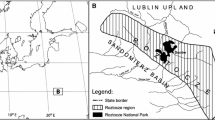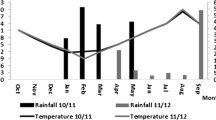Abstract
The work was carried out using a Cour trap that sampled the air of the city for 8 consecutive years (1987–1994). The pollen ofPlatanus hispanica is the fourth most abundant in the air of Seville (a mean of 11.05% of the total pollen collected). The variation throughout the years in the sum of weekly concentrations ofPlatanus hispanica pollen presents a certain biennial rhythm, in which years of high and low collection of pollen alternate. The starting day of the main pollination period (MPP) is negatively related with the mean of the mean temperatures for February (r=0.73,r 2=0.53,P=0.0398) and is earlier (at the beginning of March) when the mean temperature for February is high, and vice versa. The pattern of pollen variation inPlatanus hispanica remains constant through the years—pollen appears abruptly in high weekly concentrations (> 150 grains/m3) in March (sporadically at the beginning of April), with a week of maximum pollen emission (WMPE) in which more than 50% of the annual pollen is collected (in 6 of the 8 years), and a main pollination period (MPP) of 2 or 3 weeks (except in 1989 when it was 5 weeks). In every year (except 1989), weekly mean temperatures increased during the MPP, the duration of which depends on mean temperature and mean rainfall: mean temperatures > 16°C and absence of rainfall shorten the MPP, while lower temperatures and presence of rainfall lengthen it. The meteorological conditions most often found during the WMPE are mean temperatures > 15°C and rainfall absent or almost so.
Similar content being viewed by others
References
Belmonte J, Botey J, Cadahia A, Roure JM. Estudio polinico de la atmósfera de Cataluña. Laboratorios Leti. Barcelona, 1990.
Bousquet J, Cour P, Guerin B, Michel FB. Allergy in the Mediterranean area I. Pollen counts and pollinosis of Montpellier. Clin Allergy 1984;14:249–58.
Candau P, Conde J, Chaparro A. Palinologia enOleaceae. Incidencia de su polen en el aire de Sevilla, clínica de su polinosis. Bot Macronés 1981;8–9:89–102.
Candau P, González Minero FJ. Relationship between vegetation and pollen spectrum in SW Spain. Israel J Bot 1992;41:285–95.
Candau P, González Minero FJ, Romero F. Aeropalynology ofFraxinus (Ash) in an urban area in SW Spain. Aerobiologia 1994;10:47–51.
Caramiello R, Siniscalco R. Pollen calendar in northern Italy and its relationship to climate. Aerobiologia 1990;6(2):116–21.
Cepeda JM, Candau P. Contribución aeropalinológica al estudio de la influencia de los factores climáticos sobre la floración dePlatanus hybrida Brot.,Citrus sp. yOlea europaea L. In: Blanca G, Díaz de la Guardia C, Rodríguez-Gracia MI, Romero García AT, editors. Granada: Polen y esporas y sus aplicaciones, 1990:329–333.
Corden JM, Millington WM. A study ofGramineae ofUrticaceae pollen in the Derby area. Aerobiologia 1991;7:100–6.
Cour P. Nouvelles techniques de detection des flux polliniques: étude de la sedimentation des pollens á la surface du sol. Pollen et spores 1974;16:103–41.
Chapman JA. Aeroallergens in south-eastern Missouri USA. Grana 1986;25:235–46.
D’Amato G, Spieksma FTM. Allergenic pollen in Europe. Grana 1991;30:67–70.
Domínguez-Vilches E, García-Pantaleón F, Galán Soldevilla C, Guerra Posadas F, Villamandos de la Torre F. Variations in the concentrations of airborneOlea pollen and associated pollinosis in Córdoba (Spain): a study of the 10- year period 1982–1991. J Invest Allergol Clin Immunol 1993;3(3):121–9.
Emberlin J, Norris-Hill J. Annual, daily and diurnal variation ofUrticaceae pollen of north-central London. Aerobiologia 1991;17:49–57.
Eriksson NE, Wihl JA, Arrendal H, Strandhere SO. Tree pollen allergy. Allergy 1987;42:205–14.
Fernández P, Diaz de la Guardia C, Valle F. Análisis polínico en la atmósfera de Granada, resultados febrero-junio (1989–1990). An Asoc Palinol Leng Esp 1990;5:29–38.
Fornaciari M, Bricchi E, Giannoni C, Greco F, Fascini D, Frenguelli G. Daily variations ofUrticaceae pollen count and influence of meteoclimatic parameters in east Perugia during 1989. Aerobiologia 1992;8(3):401–6.
Frenguelli G, Bricchi E, Romano B, Mincigrucci G, Spieksma FTM. A predictive study on the beginning of the pollen season forGramineae andOlea europaea L. Aerobiologia 1989;5:64–70.
Gioulekas D, Chatzigeorgiou G, Lykogiannis S, Papakosta D, Mpalafoutis C, Spieksma FTM.Olea europaea 3-year pollen record in the area of Thessaloniki, Greece and its sensitizing significance. Aerobiologia 1991;7(1):57–61.
González Minero FJ, Candau P. Prediction of the beginning of the olive full pollen season in south-west Spain. Aerobiologia 1996;12:91–6.
González Minero FJ, Candau P.Olea europaea airborne pollen in southern Spain. Ann Allergy, Asthma Immunol 1997;78:278–84.
González Romano ML, Candau P, González Minero FJ. Pollen calendar of Seville and its relation to allergies. J Invest Allergol Clin Immunol 1992;2(6):323–8.
Iglesias I, Jato V, Izco J. Contenido polínico de la atmósfera de la ciudad de Orense, primeros resultados, (marzo 1986-marzo 1987). Ann Asoc Palinol Leng Esp 1988;4:54–63.
Jager S, Spieksma FThM, Nolard N. Fluctuations and trends in airborne concentrations of some abundant pollen types, monitored at Vienna, Leiden and Brussels. Grana 1991;30:309–12.
Lewis WH, Vinay P, Zenger V. Airborne and allergenic pollen of North America. John Hopkins Press, Baltimore, 1983.
Macchia L, Caiaffa MF, D’Amato G, Trursi A. Allergenic significance ofOleaceae pollen. In: D’Amato G, Spieksma FTM, Bonini S, editors. Allergenic Pollen and Pollinosis in Europe. Oxford: Blackwell, 1991 87–93.
Majas FD, Noetinger M, Romero EJ. Airborne pollen and spores monitoring in Buenos Aires city: a preliminary report Part I. Trees and shrubs (AP). Aerobiologia 1992;8(2):285–96.
Negrini AC. Pollens as allergens. Aerobiologia 1992;8:9–15.
Negrini AC, Voltolini S, Troise C, Arobba D. Comparison betweenUrticaceae (Parietaria) pollen count and hay fever symptoms: assessment of a ‘threshold value’. Aerobiologia 1992;8(3):325–31.
Pathirane L. Graphical determination of the main pollen season. Pollen Spores 1975;17:609–10.
Roses-Codinachs M, Suárez-Cervera M, Márquez J, Torres J. An aerobiological study of pollen grains and fungal spores of Barcelona (Spain). Aerobiología 1992;8(2):255–66.
Roure JM, Belmonte J. Primeros resultados para el estudio de las relaciones entre la producción polínica y producción de biomasa de las comunidades forestales. Actas de Palinología (VI Simposio de Palinología A.P.L.E.). Salamanca 1988;6:205–9.
Sáenz Laín C, Gutiérrez Bustillo AM. El contenido polínico de la atmósfera de Madrid. An Jardín Bot de Madrid 1983;39(2):433–63.
Solomon WR. Aerobiology of pollinosis. J Allergy Clin Immunol 1984;74:449–61.
Spieksma FThM, Van den Assem A, Collette BJA. Airborne pollen concentration in Leiden, The Netherlands, 1977–1981. II.Poaceae (grasses), variations and relation to hay fever. Grana 1985;24:88–108.
Stanley L, Linskens C. Pollen. In: Biology, Biochemistry, Management. Berlin: Springer, 1974.
Subiza J, Masiello JM, Subiza JL, Jerez M, Hinojosa M, Subiza E. Prediction of annual variation atmospheric concentrations of grass pollen: a method based on meteorological factors and grain crop estimates. Clin Allergy 1991;22:540–6.
Subiza J, Cabrera M, Valdivieso JL, Subiza M, Jerez M, Jiménez JA, Narganes MJ, Subiza E. Seasonal asthma caused by airbornePlatanus pollen. Clin. Exp. Allergy 1994;24:1123–9.
Surinyach R, Montserrat P, Font R. Epidemiología de la polinosis en Barcelona. An Med 1956;42:36–62.
Wallin JE, Segerstrom U, Rosnhall L, Bergmann E, Hjelmroos M. Allergic symptoms caused by long-distance transported birch pollen. Grana 1991;30:265–8.
Author information
Authors and Affiliations
Rights and permissions
About this article
Cite this article
Minero, F.J.G., Candau, P. Study onPlatanus hispanica Miller pollen content in the air of Seville, southern Spain. Aerobiologia 13, 109–115 (1997). https://doi.org/10.1007/BF02694426
Received:
Revised:
Accepted:
Issue Date:
DOI: https://doi.org/10.1007/BF02694426




